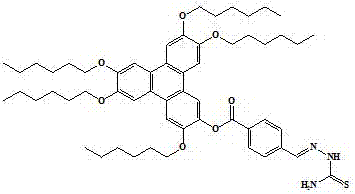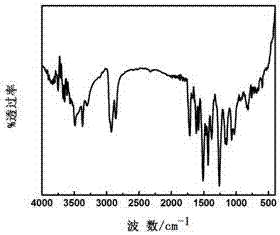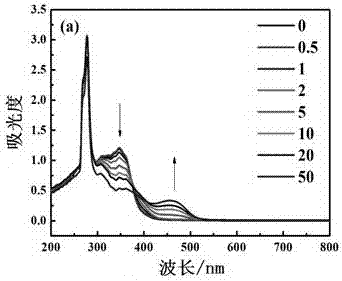Triphenylene anion recognition receptor containing thiosemicarbazide thiosemicarbazide Schiff base side chain and its application
A technology containing thiosemicarbazide and thiosemicarbazide, applied in the field of anion recognition
- Summary
- Abstract
- Description
- Claims
- Application Information
AI Technical Summary
Problems solved by technology
Method used
Image
Examples
Embodiment
[0022] The specific steps for preparing the triphenylene anion recognition receptor containing the thiosemicarbazide thiosemicarbazide Schiff base side chain are:
[0023] (1) Synthesis of dihexyloxyphenol: Measure 30mL of absolute ethanol in a 50mL three-neck flask, put it into a clean magnet, weigh potassium iodide (0.249g, 0.0015mol), 1-bromo-n-hexane ( 5.9g, 0.036mol) and catechol (3.3g, 0.030mol) were added into a three-necked flask, and the magnetic stirrer was turned on to stir and dissolve. After the catechol is completely dissolved, weigh anhydrous potassium carbonate (4.55g, 0.033mol) and slowly add it into the above-mentioned three-necked flask under stirring conditions. After adding the anhydrous potassium carbonate, protect the device with nitrogen, and then Stir at room temperature for 1 hour. The temperature of the oil bath was controlled at 80 °C and heated to reflux. After reacting for 12 hours, the heating was stopped and cooled to room temperature, and the...
PUM
| Property | Measurement | Unit |
|---|---|---|
| melting point | aaaaa | aaaaa |
Abstract
Description
Claims
Application Information
 Login to View More
Login to View More - R&D Engineer
- R&D Manager
- IP Professional
- Industry Leading Data Capabilities
- Powerful AI technology
- Patent DNA Extraction
Browse by: Latest US Patents, China's latest patents, Technical Efficacy Thesaurus, Application Domain, Technology Topic, Popular Technical Reports.
© 2024 PatSnap. All rights reserved.Legal|Privacy policy|Modern Slavery Act Transparency Statement|Sitemap|About US| Contact US: help@patsnap.com










